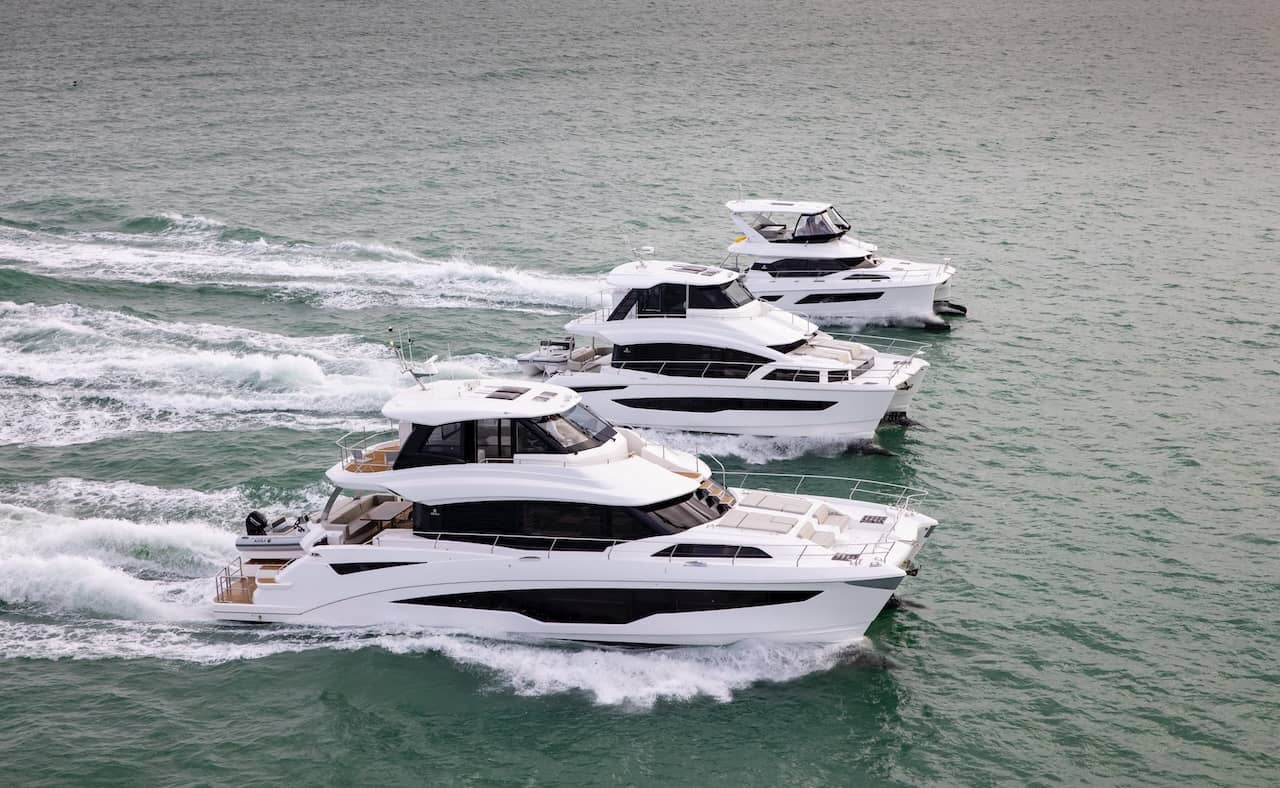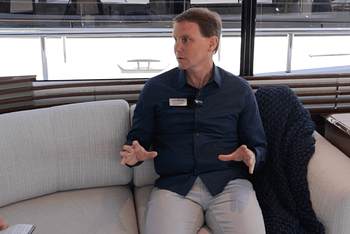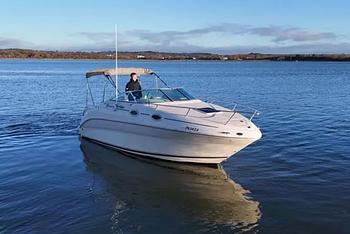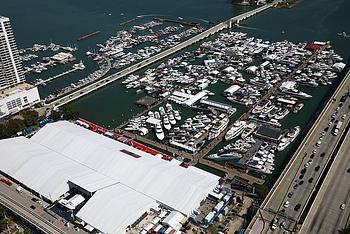Jean Raas is the CEO of Aquila Power Catamarans in the U.S., and head of product development. A former member of the U.S. Windsurfing Team, Raas has spent his life on and around the water. He has worked with Aquila, which is owned by Sino-Eagle Yachts, since the 2012 launch of its first powercat in a partnership that included MarineMax, the largest boat and yacht dealer in the world. Currently, the Aquila brand has 10 models across multiple market segments, with more to come. Rightboat’s content director, John Burnham, spoke with Raas a couple weeks before the Ft. Lauderdale International Boat Show.

Jean Raas at the helm of the new Aquila 50 Yacht
John Burnham: Just how big is Aquila and its parent company today?
Jean Raas: Aquila has 10 models across four lines, ranging from sportboats to yachts, to offshore fishing and luxury yachts. We have close to 100 dealers internationally, and Aquila’s parent company is Sino-Eagle Yachts in Hangzhou, China. The boats are built there in a million-square-foot factory that has a high focus on the environment by utilizing solar panels on roof tops and air and water filtering systems to reduce CO2 emissions. In addition to that, we are currently looking at other factory locations so that we can continue expanding our marine segments within Aquila. Sino Eagle has invested heavily into vertically integrating our manufacturing processes in order to have more control over our products. Investments such as developing our in-house cushion manufacturing team, stainless steel, aluminum fuel tanks, and 5-axis milling machines to name a few. We're utilizing every square inch of that factory right now!

The busy Aquila factory in Hangzhou, China
Burnham: The power catamaran segment is growing. What kind of shift do you see in recent years, and why should potential buyers seriously consider moving from monohulls to catamarans?
Raas: You and I both come from a sailing background. I grew up sailing with my dad and spent many hours on the water, and then also was part of the US Windsurfing team for a number of years and tried out for the Olympics. Through the years, what you and I have seen is that when sailing catamarans came out, everybody said, “Well, no, you can't do that. It's totally different to monohull sailing.” But as people started to see the benefits of what a catamaran is, they quickly realized if you're cruising or doing any type of entertainment, catamarans have a lot of benefits. Now, when you go to a charter facility in the Mediterranean or the Caribbean, the majority of what you see on the water is sailing catamarans.
On the powerboat side, we saw the opportunity to create Aquila from the ground up with a true powercat hull. We saw an opportunity to go after the monohull powerboat side of things and bring more powercats into the market. Yes, there were other powercats out there, and they were not the best-looking boats, which steered people away from this market. When we started Aquila, we wanted to focus on a good-looking boat that, from the side, you really can't tell it's a powercat. At the same time, you get the benefits of efficiency, performance, and usability of the space on board—so many benefits in comparison to a monohull. When one looks at a house, one of the first things people look at is the square footage of that house. However, in the marine industry, we are always focused on what the length of the boat is. If one takes one of our power catamaran models and compares the square footage of useable space against a monohull power boat, you very quickly see where the benefits are in terms of useable space onboard and then, on top of that, the added benefits of performance and efficiency.
It’s pretty evident the market is swinging that way because of how many players you are starting to see in the market since the Covid days started. There are a ton of new brands or existing brands that have all of a sudden jumped into this powercat market. We've been the leaders on that side of things, and we will continue to be the leaders with the new segments and models we're currently developing.

Three models in the Aquila Yacht lineup are the 70L, 54Y and 44Y.
Burnham: Will this shift make it easier for you to sell Aquilas, or is the competition going to make it more difficult?
Raas: It’s good to see these competitors come in, because the more cats you get out there, the more customers are going to see and become more acquainted with catamarans. And then they'll do their research to find out what boat best fits their needs. That's the advantage of what we have with Aquila, is that we have all these different segments we're into. Whether it be a yacht and they're going to do some extended offshore cruising with their family, or a sport boat to run out to the islands, or spend a weekend somewhere fishing. Compared to our competitors, we offer one of every different type of boat within our growing segments.
Burnham: Across market segments, what's the common denominator among all those models besides having two hulls?
Raas: The most common denominator is that all of our boats have been built to the highest of standards. We use vinylester resin, not polyester, during the infusion process, which are all within a temperature- and humidity-controlled area. That sets us apart compared to our competitors. It also bonds more effectively to the PVC core materials than other types of resins so delamination is not an issue. We use carbon fiber in some of our main structural bulkheads on some models, not all, which increases overall strength and maintains the weight targets we're looking for. In some cases, we'll do a solid carbon bulkhead; in other cases, we just use carbon reinforcement within the bulkhead. The whole infusion process makes everything stronger, lighter, and more rigid. You’ll walk on our decks and on a competitor's deck and quickly feel the strength and rigidity around how we build our boats.

An Aquila 47 Molokai hull under construction with fore-and-aft carbon fiber bulkheads
Burnham: Is there anything else that we can count on in all Aquila boats?
Raas: From the start of the initial concept of the boat design, we spend a ton of time with our designers on hull shape, which is based around our experience since the initial start of Aquila. We also have the experience of Lex Raas [Jean’s father], with his past experience of being a part of the design process at Robertson and Caine boats. We were able to bring a lot of that knowledge from his side into the design process, along with working with our world-renowned designers.
At the initial steps of the design, we say, “OK, what speeds do we want this model to run at, and how do we get that maximum efficiency gain, while at the same time being able to truly take on offshore conditions when it gets rough out there?” That includes items such as raised bridge decks and increased widths between the sponsons that attribute to a really good running Aquila boat. As we design the hull shapes, we run a high number of CFDs [computational fluid dynamics simulations] to optimize and make slight adjustments to hull shape, beam, tunnel width and height. On our Yacht models, we refine the shapes of the bulbous bows. And on the faster boats, we're bringing steps into the hull shapes for better efficiency.
One last common denominator is the CE certification. We go for the highest standards. The CE certification for all of our yacht models is Class A, and then within our other segments, we focus on shooting for the highest, which is typically a B standard, which we’ll also incorporate all the way down to D.
Burnham: Coming from the sailing side, I'm used to discussing hull shapes and bridgedeck heights for cruising catamarans. What strikes me is how, in the powercat market, performance takes on a new dimension. You're not just going along at eight knots!
Raas: Even the difference between the yacht models, typically around 20 knots or so, and the fishing segment, with speeds of 60 plus miles per hour. And the Coupe and Sport lineups, which run within the 50 mile per hour range, or slightly below that. You have all these different types of boats you have to adjust your hull shapes to. You can't just come out with one and say you've nailed it. You’re constantly testing different things until you're happy with the final outcome. Even after the prototypes are done, we're still tweaking. We do a ton of prop testing—for example, we ran the 47 Molokai and, we found props that we felt were really good for the boat, and then we sent the boat to the Lake X Mercury testing facility, and they said, “You guys have done an amazing job at getting the ideal engine heights, the props, the installation.” There are lots of little things like that which take time during the prototype-testing process but in turn pay off in the end.

In profile, the Aquila 50Y looks more like a monohull.
Burnham: Now you have a new Aquila 50Y, the latest yacht style powercat in your lineup. What is its most innovative feature and how does it define the future for future Aquila models?
Raas: The 50 is a very tough-looking boat, but at the same time has these beautiful lines that give her that appearance of just a really strong, but good-looking boat. How we did that was we looked at what direction the super yachts were going in terms of styling. And what we've noticed is that a lot of them are going towards this Explorer look with big hull-side windows or the raised gunnels. We realized we can really benefit from this with the master cabin, which typically on the larger yacht models you have to take steps down on the port and starboard side, but on the 50 we are able to have a single level, full beam master cabin—no steps on the side plus these massive windows. The amount of space in that master cabin is amazing.
Raas: It also opened opportunities for us to really utilize the bow section for an entertainment space more than we've done in the past—an excellent entertainment space up front with sunbeds and various seating places. And we also had a hard look at the flybridge. And we noticed that we had an opportunity there to do an asymmetric shape by only utilizing one side of the flybridge for the bow-to-flybridge access that we always have. As a result, the flybridge on this boat is massive.
In addition, the raised freeboards allow us to bring the bridgedeck height up and maintain that beam, the width in between the two tunnels. Then bring in our bulbous bows as well and we have a really good feel to the boat, keeping the bow up in any type of condition.
Along with that, we've also made sure that with the straight shaft installation on the engines, we've allowed enough space between the engine and the bulkheads to be able to offer a hybrid option. That'll be coming in the near future. And we're currently testing foils for the boats as well, so once we get that nailed down, we'll be bringing that to the market as an option.

Featuring bulbous bows of glass and foam below the waterline, a row of Aquila 54Y and 50Y models face a lineup of 44Y and 42Y models at the Hangzhou, China factory.
Burnham: I want to come back to the foil testing, but first, talk a little more about the bulbous bows. I once chartered an Aquila 48, back when Marine Max first opened their BVI charter base. I remember having to go slowly into very short waves. I'm curious if these bulbous bows make a dramatic change to that.
Raas: The 48 was our original model. Before that, we had the 38 to get the brand going. It was a modified Leopard 37 powercat; we purchased the molds from Robertson and Caine. So, then we started with the 48, which did not have bulbous bows and had a relatively low bridge deck height. Next came the 44 and at first without the bulbous bows; when we added them, we immediately noticed that, firstly, the boat could get up on the plane faster because we increased the waterline length. Secondly, as you mentioned in that chop, instead of starting to hobby horse, it would maintain that bow-up ride, and when the boat would come down, it would quickly pop back up. That's when we said, “OK, this is a trademark we gotta keep within our Aquila DNA, because we know it works.” Since then, we have made sure we have the bulbous bow design brought into our yacht lineup with a focus on tunnel height and width giving exceptional offshore performance ability.
Burnham: What is a bulbous bow?
Raas: Bulbs at the forward portion of the hull mitigate the hobby-horsing effect some boats experience as they rock over undulating sea states. The bulbs are cored with foam and react like a basketball when you push them underwater. They don’t sink far below the surface and they push the bow up. The effect is a smoother ride.
Burnham: I have always thought of bulbous bows increasing waterline length and average hull speed for large ships, but obviously, there's more to it. I want to go back to the foils. I saw a video on your website showing foils between the hulls, and also little foils aft, extending from the hulls. Is that what you would expect them to look like eventually, or is it still early days?

The main foil spans the space between the two hulls.
Raas: We focus on a semi-foiling concept—not full foiling. Between the two hulls we have a fixed foil, sort of on the boat’s ‘midship. The foil shape depends on the speeds we're looking to get out of the boats. For example, on the sport boats, once you go above 50mph, the foil starts to get a bit too fast for the boat and you start to get too much lift. So, we always focus on the foils being at maximum efficiency at cruise speed. That's what that main foil would do at amidship. The aft foils are really stabilizer wings that help the boat get up on plane, but once they're up, they're really not doing a whole lot other than adding stability.
On the 36 Sport, we're getting efficiency gains of 35 percent compared to the non-foiling boat, which means you could go with smaller engines as well. Your engines aren’t working as hard. On bigger boats, you have more weight, and you've got a bigger foil section, so there's quite a bit of testing of foils and props. It's not as easy to change props out on the bigger boats, so it’s a bit more of an R&D process until we are comfortable bringing it to market. We did a lot of testing on our new 42 Yacht, and now we have just delivered our first 42 Yacht with foils in the US to a customer, and the efficiency and ride and everything about that boat has transformed it. It was already a good riding boat, but to add on the foils, it really is a super good running boat, and you're almost getting 30 miles per hour.
Burnham: When you say efficiency, is that extra speed for the same amount of power, or is it fuel economy?
Raas: We're not looking at gaining a huge amount of extra top end speed, but at cruise speed, at the same RPMs, you're getting a little bit higher speed. Your fuel efficiency is where you're getting the most gains. The foils provide fuel efficiency and reduce how hard the engines are working.
Burnham: The new 50 Yacht will be at Fort Lauderdale. If somebody says, I like the boat, but I want foils on it. What would you say?
Raas: Once we have the initial testing nailed down, we'll share the results with the customer, and then he can make his decision whether or not to add the foils on or not. We'll have true data to share with them.

Aquila plans to reveal a new Coupe line in early 2025.
Burnham: After the 50 Yacht, you’re introducing a 40-foot coupe in Miami, first in a new line?
Raas: The 40 Coupe has actually grown two feet and it's a 42 Coupe now. We are hoping to also have the flagship of the new Coupe line there as well, our 46 Coupe. So timing is tight, but we're hoping to get both boats there for the Miami show. What you'll see is these boats are very stylish and sleek looking. Again, we maintain that typical monohull look, so you can't really tell it's a catamaran from the side. It’s a fully enclosed coupe-style boat that gives the owner the ability to bring the outside elements inside the boat. It has a massive opening skylight, and then also aft doors that open and the forward door section that also opens. The cabins are good sized with nice windows, so a very open feeling, and they have a separate shower and head inside. The other thing that we're bringing into the lineup is carbon fiber foils—a fixed foil between the two hulls. Our initial testing on the 42 has us right around 38 percent in efficiency at cruise speeds with those foils. For engine packages, you can either option it out with outboard engines or go with Volvo Penta DPI inboard diesels.
It's going to be a completely new range, not superseding any other models and a brand new segment. And in our sport boat lineup, we're also working on new models, which we will be introducing next year.

The A32S and A36S sportboat models in the production line
Burnham: From a customer point of view, why would I buy a Sport versus a Coupe?
Raas: The sport boat lineup is more of that day-boat function with open deck space— it's not an enclosed boat. It's a completely open boat. At the same time, we've brought in some really cool features. We are still offering a cabin on the boat, but it'll just be a one cabin, not two, whereas the coupes will have two cabins. The sport boat is geared towards those running out to islands or maybe spending a longish weekend aboard whereas the coupe boats give you the ability to spend a week on the boat. You can bring guests on board to stay onboard as well. The sport boat has a higher speed, in the 55 to 60 mile per hour range, whereas the coupes will be on a cruise speed of around 35 to 40mph.
Burnham: One thing about being in several market segments is they all demand new product. How do you manage to develop four lines at the same time?
Raas: It's a good thing we have excellent designers on our side. Over the years, we’ve really fine tuned where the real strength of each of those designers is, like J & J Design, who have been really successful with our Yacht lineup. VPLP Design has been great on that side of things as well along with our foil development. And then we've used Peart Yacht Design for the Coupe and also the fishing segment. And J & J Design has also been involved in the 42 Coupe. Morelli & Melvin also played a big part in the success of our Aquila 36S foil option and the designs of our smaller 14- and 17-foot RIBs. So, we've really had the opportunity over the years to see where each of those designers fit in well for each of those segments. And we're always learning and thinking, “What is the next vision to stay ahead?”
For example, the 36 Sport we came out with quite a few years ago. And that was a whole new model that hit the market that nobody had really gotten into with the outboard concept on powercats. It offered two cabins, unique for that size of boat. And we've been ahead of the rest of the players that are coming into the market because we know what customers are looking for. And that's why we've come out with the Coupe line. As we develop the other existing segments, again, we know what guys are looking for and the size ranges that we need to be within the target speeds, the cabin layouts for that size boat, and also that we're ahead of the game in terms of electrical systems.
Raas: We've got a lot in the pipeline—these are just a few of the models coming along. Obviously, the market is in a bit of a downturn right now, and how we stay ahead of that is introducing new models within the various segments. For example, in our fishing segment, we're going to be coming out with a new model that's going to fit between the 47 and the 28 and we're further expanding on that right now. Aquila is going to be a strength in the future in terms of how many new models we'll introduce.




